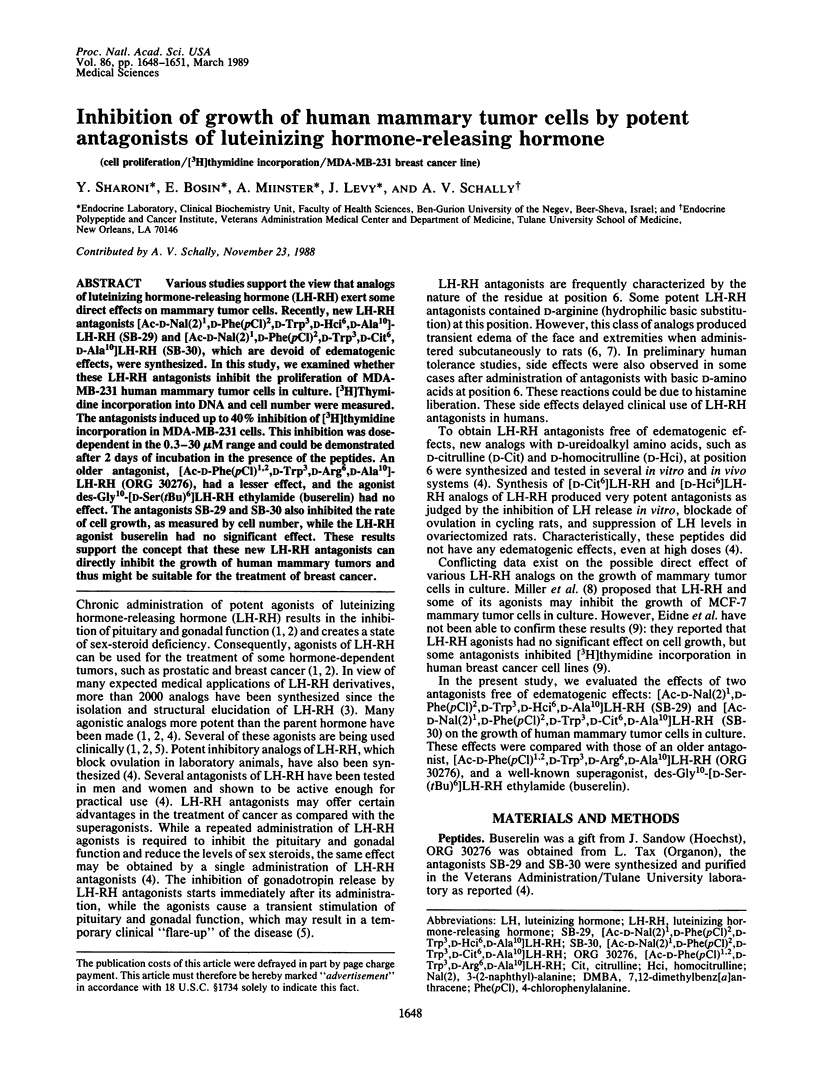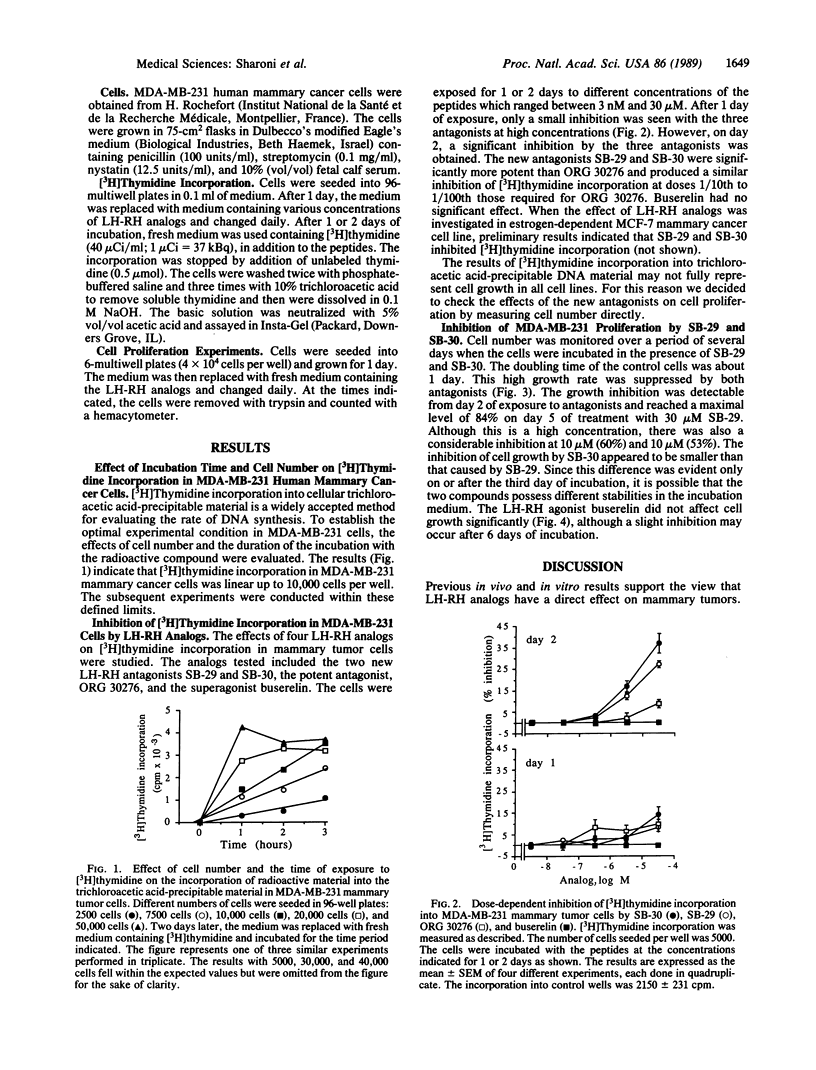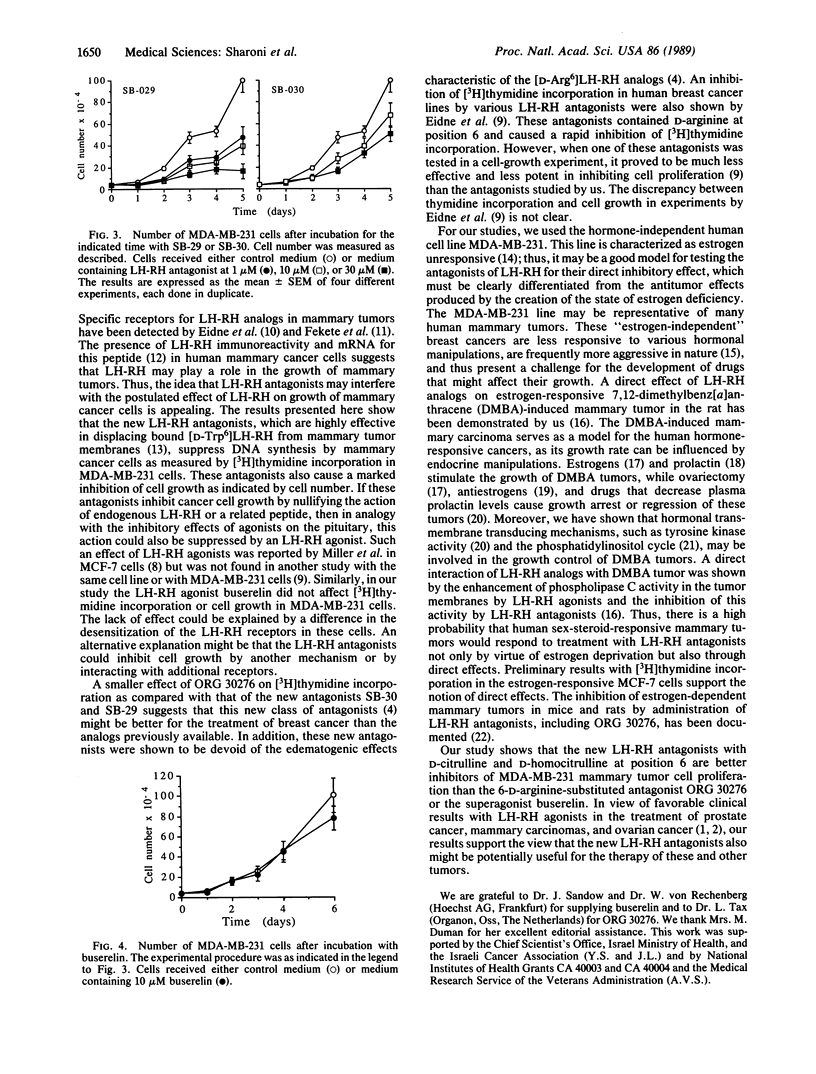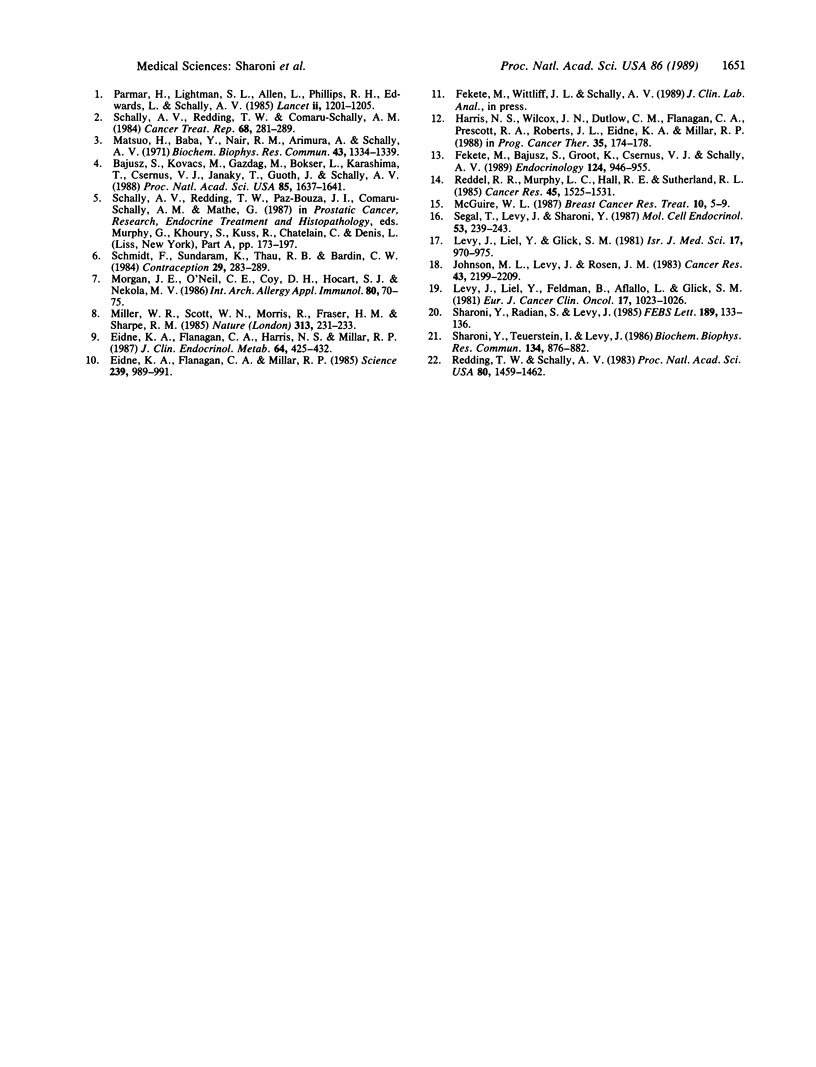Abstract
Various studies support the view that analogs of luteinizing hormone-releasing hormone (LH-RH) exert some direct effects on mammary tumor cells. Recently, new LH-RH antagonists [Ac-D-Nal(2)1,D-Phe(pCl)2,D-Trp3,D-Hci6,D-Ala10]-LH-RH (SB-29) and [Ac-D-Nal(2)1,D-Phe(pCl)2,D-Trp3,D-Cit6,D-Ala10]LH-RH (SB-30), which are devoid of edematogenic effects, were synthesized. In this study, we examined whether these LH-RH antagonists inhibit the proliferation of MDA-MB-231 human mammary tumor cells in culture. [3H]Thymidine incorporation into DNA and cell number were measured. The antagonists induced up to 40% inhibition of [3H]thymidine incorporation in MDA-MB-231 cells. This inhibition was dose-dependent in the 0.3-30 microM range and could be demonstrated after 2 days of incubation in the presence of the peptides. An older antagonist, [Ac-D-Phe(pCl)1,2,D-Trp3,D-Arg6,D-Ala10]-LH-RH (ORG 30276), had a lesser effect, and the agonist des-Gly10-[D-Ser(tBu)6]LH-RH ethylamide (buserelin) had no effect. The antagonists SB-29 and SB-30 also inhibited the rate of cell growth, as measured by cell number, while the LH-RH agonist buserelin had no significant effect. These results support the concept that these new LH-RH antagonists can directly inhibit the growth of human mammary tumors and thus might be suitable for the treatment of breast cancer.
Full text
PDF



Selected References
These references are in PubMed. This may not be the complete list of references from this article.
- Bajusz S., Kovacs M., Gazdag M., Bokser L., Karashima T., Csernus V. J., Janaky T., Guoth J., Schally A. V. Highly potent antagonists of luteinizing hormone-releasing hormone free of edematogenic effects. Proc Natl Acad Sci U S A. 1988 Mar;85(5):1637–1641. doi: 10.1073/pnas.85.5.1637. [DOI] [PMC free article] [PubMed] [Google Scholar]
- Eidne K. A., Flanagan C. A., Harris N. S., Millar R. P. Gonadotropin-releasing hormone (GnRH)-binding sites in human breast cancer cell lines and inhibitory effects of GnRH antagonists. J Clin Endocrinol Metab. 1987 Mar;64(3):425–432. doi: 10.1210/jcem-64-3-425. [DOI] [PubMed] [Google Scholar]
- Eidne K. A., Flanagan C. A., Millar R. P. Gonadotropin-releasing hormone binding sites in human breast carcinoma. Science. 1985 Sep 6;229(4717):989–991. doi: 10.1126/science.2992093. [DOI] [PubMed] [Google Scholar]
- Fekete M., Bajusz S., Groot K., Csernus V. J., Schally A. V. Comparison of different agonists and antagonists of luteinizing hormone-releasing hormone for receptor-binding ability to rat pituitary and human breast cancer membranes. Endocrinology. 1989 Feb;124(2):946–955. doi: 10.1210/endo-124-2-946. [DOI] [PubMed] [Google Scholar]
- Johnson M. L., Levy J., Rosen J. M. Isolation and characterization of casein-producing and -nonproducing cell populations from 7,12-dimethylbenz(a)anthracene-induced rat mammary carcinomas. Cancer Res. 1983 May;43(5):2199–2209. [PubMed] [Google Scholar]
- Levy J., Liel Y., Feldman B., Aflallo L., Glick S. M. Peroxidase activity in mammary tumors - effect of tamoxifen. Eur J Cancer Clin Oncol. 1981 Sep;17(9):1023–1026. doi: 10.1016/s0277-5379(81)80008-9. [DOI] [PubMed] [Google Scholar]
- Levy J., Liel Y., Glick S. M. Peroxidase activity as a marker for estrogenicity: studies in uterus and mammary tumors. Isr J Med Sci. 1981 Sep-Oct;17(9-10):970–975. [PubMed] [Google Scholar]
- Matsuo H., Baba Y., Nair R. M., Arimura A., Schally A. V. Structure of the porcine LH- and FSH-releasing hormone. I. The proposed amino acid sequence. Biochem Biophys Res Commun. 1971 Jun 18;43(6):1334–1339. doi: 10.1016/s0006-291x(71)80019-0. [DOI] [PubMed] [Google Scholar]
- McGuire W. L. Prognostic factors for recurrence and survival in human breast cancer. Breast Cancer Res Treat. 1987 Oct;10(1):5–9. doi: 10.1007/BF01806129. [DOI] [PubMed] [Google Scholar]
- Miller W. R., Scott W. N., Morris R., Fraser H. M., Sharpe R. M. Growth of human breast cancer cells inhibited by a luteinizing hormone-releasing hormone agonist. Nature. 1985 Jan 17;313(5999):231–233. doi: 10.1038/313231a0. [DOI] [PubMed] [Google Scholar]
- Morgan J. E., O'Neil C. E., Coy D. H., Hocart S. J., Nekola M. V. Antagonistic analogs of luteinizing hormone-releasing hormone are mast cell secretagogues. Int Arch Allergy Appl Immunol. 1986;80(1):70–75. doi: 10.1159/000234028. [DOI] [PubMed] [Google Scholar]
- Parmar H., Phillips R. H., Lightman S. L., Edwards L., Allen L., Schally A. V. Randomised controlled study of orchidectomy vs long-acting D-Trp-6-LHRH microcapsules in advanced prostatic carcinoma. Lancet. 1985 Nov 30;2(8466):1201–1205. doi: 10.1016/s0140-6736(85)90739-1. [DOI] [PubMed] [Google Scholar]
- Reddel R. R., Murphy L. C., Hall R. E., Sutherland R. L. Differential sensitivity of human breast cancer cell lines to the growth-inhibitory effects of tamoxifen. Cancer Res. 1985 Apr;45(4):1525–1531. [PubMed] [Google Scholar]
- Redding T. W., Schally A. V. Inhibition of mammary tumor growth in rats and mice by administration of agonistic and antagonistic analogs of luteinizing hormone-releasing hormone. Proc Natl Acad Sci U S A. 1983 Mar;80(5):1459–1462. doi: 10.1073/pnas.80.5.1459. [DOI] [PMC free article] [PubMed] [Google Scholar]
- Schally A. V., Redding T. W., Comaru-Schally A. M. Potential use of analogs of luteinizing hormone-releasing hormones in the treatment of hormone-sensitive neoplasms. Cancer Treat Rep. 1984 Jan;68(1):281–289. [PubMed] [Google Scholar]
- Schally A. V., Redding T. W., Paz-Bouza J. I., Comaru-Schally A. M., Mathe G. Current concept for improving treatment of prostate cancer based on combination of LH-RH agonists with other agents. Prog Clin Biol Res. 1987;243A:173–197. [PubMed] [Google Scholar]
- Schmidt F., Sundaram K., Thau R. B., Bardin C. W. [Ac-D-NAL(2)1,4FD-Phe2,D-Trp3,D-Arg6]-LHRH, a potent antagonist of LHRH, produces transient edema and behavioral changes in rats. Contraception. 1984 Mar;29(3):283–289. doi: 10.1016/s0010-7824(84)80008-6. [DOI] [PubMed] [Google Scholar]
- Segal T., Levy J., Sharoni Y. GnRH analogs stimulate phospholipase C activity in mammary tumor membranes: modulation by GTP. Mol Cell Endocrinol. 1987 Oct;53(3):239–243. doi: 10.1016/0303-7207(87)90179-1. [DOI] [PubMed] [Google Scholar]
- Sharoni Y., Radian S., Levy J. Membranal tyrosine protein kinase activity (but not cAMP-dependent protein kinase activity) is associated with growth of rat mammary tumors. FEBS Lett. 1985 Sep 9;189(1):133–136. doi: 10.1016/0014-5793(85)80857-7. [DOI] [PubMed] [Google Scholar]
- Sharoni Y., Teuerstein I., Levy J. Phosphoinositide phosphorylation precedes growth in rat mammary tumors. Biochem Biophys Res Commun. 1986 Jan 29;134(2):876–882. doi: 10.1016/s0006-291x(86)80501-0. [DOI] [PubMed] [Google Scholar]


